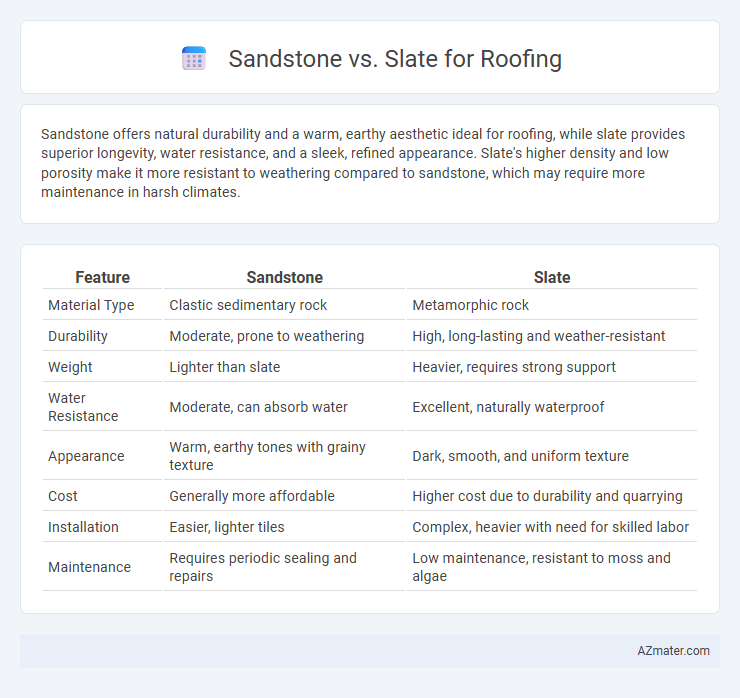Sandstone offers natural durability and a warm, earthy aesthetic ideal for roofing, while slate provides superior longevity, water resistance, and a sleek, refined appearance. Slate's higher density and low porosity make it more resistant to weathering compared to sandstone, which may require more maintenance in harsh climates.
Table of Comparison
| Feature | Sandstone | Slate |
|---|---|---|
| Material Type | Clastic sedimentary rock | Metamorphic rock |
| Durability | Moderate, prone to weathering | High, long-lasting and weather-resistant |
| Weight | Lighter than slate | Heavier, requires strong support |
| Water Resistance | Moderate, can absorb water | Excellent, naturally waterproof |
| Appearance | Warm, earthy tones with grainy texture | Dark, smooth, and uniform texture |
| Cost | Generally more affordable | Higher cost due to durability and quarrying |
| Installation | Easier, lighter tiles | Complex, heavier with need for skilled labor |
| Maintenance | Requires periodic sealing and repairs | Low maintenance, resistant to moss and algae |
Introduction to Sandstone and Slate Roofing
Sandstone roofing features natural sedimentary rock known for its durability, distinctive layered texture, and warm earthy tones that enhance architectural aesthetics. Slate roofing, derived from fine-grained metamorphic rock, offers superior longevity, water resistance, and a sleek, elegant appearance with a variety of gray, black, and green shades. Both materials provide foundational roofing solutions valued for their natural beauty and robust performance in diverse climates.
Composition and Geological Origins
Sandstone, composed primarily of compacted sand-sized mineral particles, originates from sedimentary processes involving the accumulation and lithification of sand deposits, often rich in quartz and feldspar. Slate forms from the low-grade metamorphism of shale or mudstone, causing fine clay particles to realign and crystallize into a dense, foliated rock with excellent cleavage properties. The differing geological origins give sandstone a granular, porous structure while slate's metamorphic history results in a durable, cleavable surface ideal for roofing.
Aesthetic Differences and Visual Appeal
Sandstone roofing offers a warm, earthy palette with natural textures that create a rustic and inviting appearance, often showcasing varying shades of beige, brown, and red. Slate roofing provides a sleek, sophisticated look with smooth, fine-grained surfaces and a consistent range of deep greys, blues, and blacks, enhancing modern or traditional architectural styles. The choice between sandstone and slate significantly impacts visual appeal, where sandstone emphasizes organic charm and slate delivers elegant durability.
Durability and Longevity Comparison
Sandstone roofing offers moderate durability with a lifespan of approximately 20 to 30 years, but it is more susceptible to weathering and erosion compared to slate. Slate roofing is renowned for its exceptional longevity, often lasting over 75 to 100 years due to its dense, non-porous structure that resists moisture and temperature fluctuations. The superior durability of slate makes it a preferred choice in roofing applications where extended lifespan and minimal maintenance are critical.
Weather Resistance and Performance
Sandstone and slate differ significantly in weather resistance and roofing performance, with slate offering superior durability against harsh weather conditions due to its dense, non-porous structure that resists water absorption and frost damage. Sandstone, while aesthetically pleasing, tends to be more porous and susceptible to erosion and freeze-thaw cycles, which can compromise its long-term performance on roofs. Slate's natural ability to withstand heavy rain, snow, and temperature fluctuations makes it a preferred choice for roofing in regions prone to extreme weather.
Installation Process and Complexity
Sandstone roofing requires careful cutting and precise fitting due to its variable thickness and natural rough texture, which can complicate installation and increase labor time. Slate offers a more uniform thickness and smoother surface, enabling easier handling and faster installation, though it demands skilled craftsmanship to securely fasten its brittle tiles. Both materials require specialized tools and experienced roofers, but slate tends to have a more standardized installation process compared to the more variable and labor-intensive sandstone.
Maintenance Requirements and Costs
Sandstone roofing requires regular sealing to prevent water absorption and erosion, leading to moderate maintenance costs, while slate offers exceptional durability with minimal maintenance expenses due to its natural resistance to weather and pollutants. The cost of maintaining sandstone roofs can escalate over time because of the need for frequent repairs and sealing treatments, whereas slate roofs typically incur lower long-term maintenance costs despite a higher initial installation price. Choosing between sandstone and slate hinges on balancing upfront roofing investment against ongoing maintenance budgets and lifespan expectations.
Environmental Impact and Sustainability
Sandstone roofing offers natural durability and minimal processing, resulting in lower carbon emissions compared to more energy-intensive materials. Slate, known for its exceptional longevity, reduces the need for frequent replacements, contributing to sustainable roofing through extended lifecycle use. Both materials are recyclable and sourced from abundant natural deposits, but slate's extraction impacts can be more intensive due to quarrying methods.
Cost Analysis: Sandstone vs Slate
Sandstone roofing typically costs between $5 to $10 per square foot, making it a more affordable option compared to slate, which ranges from $10 to $25 per square foot due to its durability and aesthetic appeal. Installation costs for slate are higher because of its heavier weight and the need for specialized labor and reinforcement of roof structures. Long-term maintenance expenses favor slate as it offers superior longevity and weather resistance, reducing the frequency of repairs and replacements compared to sandstone.
Choosing the Best Material for Your Roof
Sandstone and slate differ significantly in durability and appearance, making slate the superior choice for long-lasting roofing due to its higher resistance to weather and natural splitting properties. Sandstone, while aesthetically pleasing with its warm tones, is softer and prone to erosion, requiring more maintenance and shorter lifespan. Selecting the best roofing material depends on climate conditions and desired longevity, where slate offers improved resilience and minimal upkeep for roofs exposed to harsh environments.

Infographic: Sandstone vs Slate for Roofing
 azmater.com
azmater.com